Selected Papers
Chirality induction on non-chiral dye-linked polysilsesquioxane in nanohelical structures
N. Ryu, T. Kawaguchi,a H. Yanagita,b Y. Okazaki, T. Buffeteau, K. Yoshida, T. Shirosaki, S. Nagaoka, M. Takafuji, H. Ihara, R. Oda.
Chem. Commun., 2020, 56, 7241-7244
DOI: 10.1039/D0CC02224A
We demonstrate the direct induction of chirally arranged organic dye-linked polysilsesquioxane through a sol–gel transcription using a chiral supramolecular template. The chiral arrangement was confirmed by using electronic and vibrational circular dichroism and circularly polarized luminescence spectroscopies.
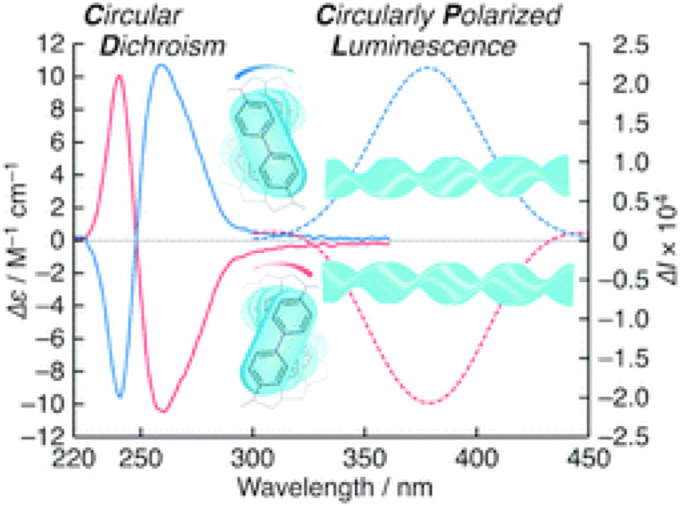
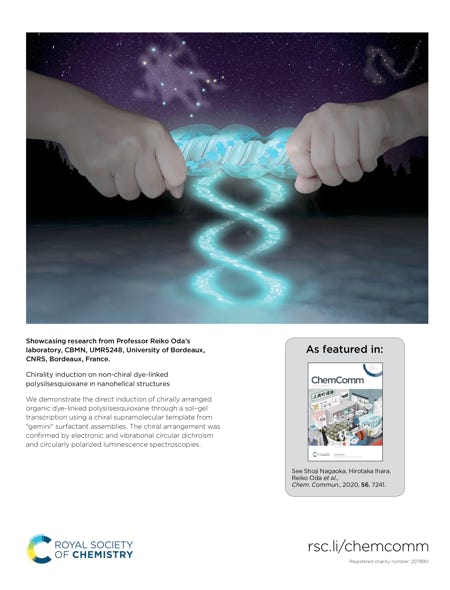
Polymer encapsulation and stabilization of molecular gel-based chiroptical information for strong, tunable circularly polarized luminescence film
H. Oishi,a S. Mashima,a Y. Kuwahara, M. Takafuji, K. Yoshida,b R. Oda,b H. Qiu, H. Ihara
J. Mater. Chem. C, 2020, 8, 8732-8735
DOI: 10.1039/D0TC01480J
We demonstrate a strategic approach for a completely organic, chiroptical polymer film, exhibiting strong (glum = 0.01–0.05) and broad-band circularly polarized luminescence that can be realized by the stabilization of self-assembly-driven secondary chirality through polymer encapsulation.
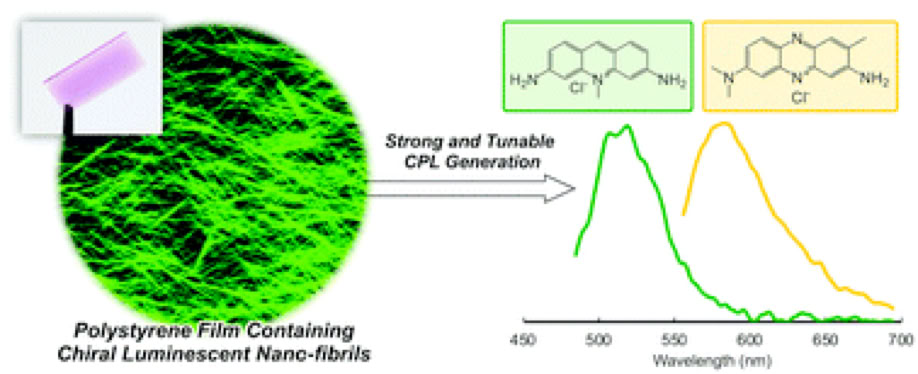
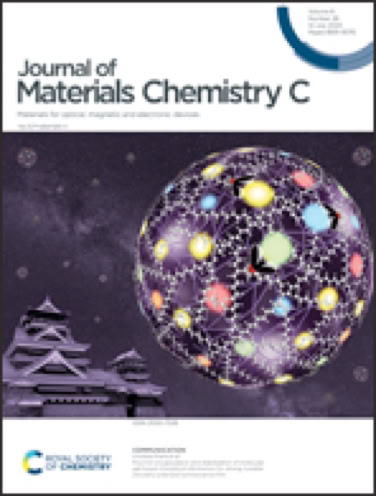
Fabrication of hollow silica microspheres with orderly hemispherical protrusions and capability for heat-induced controlled cracking
M. Takafuji*, N. Hano, Md. A. Alam, H. Ihara*.
Langmuir, Vol. 33 (40), pp 10679–10689, 2017.
Hollow silica microspheres with orderly protrusions on their outer and inner surfaces were fabricated in three simple steps: (1) suspension polymerization of a polymerizable monomer containing silica nanoparticles to obtain polymeric microspheres with a layered shell of silica particles; (2) sol–gel reaction of tetraethoxysilane (TEOS) on the surface of the microspheres to connect the silica nanoparticles; (3) removal of polymer core by calcination. The shell composed of silica-connected silica nanoparticles remained spherical even after calcination, and the characteristic surface morphology with protrusions were obtained on both inner and outer surfaces. Measurements of the mechanical strength revealed that the compression modulus of the hollow microspheres increased with increasing thickness of the silica layer, which could be controlled by changing the concentration of TEOS in the sol–gel reaction. Rapid heating of the hollow silica microspheres with the thin silica-connected layer led to silica shell cracking, and the cracks were mostly observed in the connecting layer between the silica nanoparticles. The stress was probably concentrated in the connecting layer because of its lower thickness than the nanoparticles. Such characteristic of the hollow microspheres is useful for a capsule with capability for heat-induced controlled cracking caused by internal pressure changes.
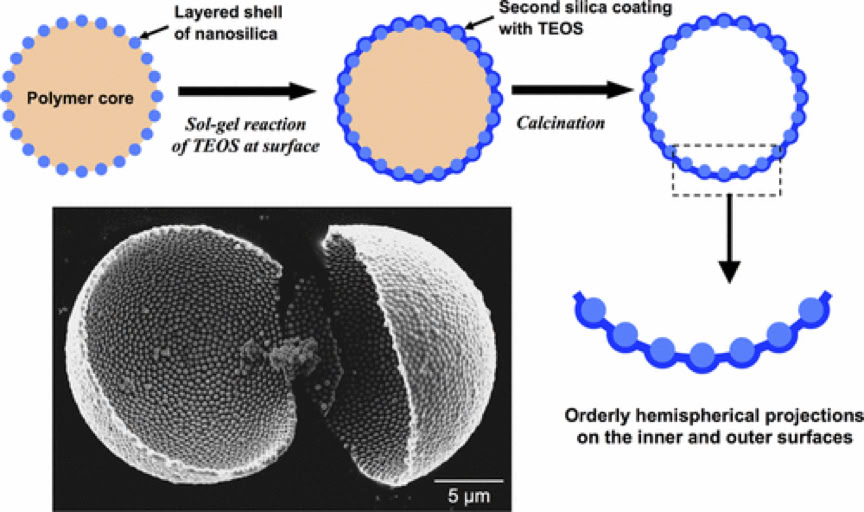
One-pot preparation of polymer microspheres having wrinkled hard surfaces through self-assembly of silica nanoparticles.
N. Hano, M. Takafuji*, H. Ihara*.
Chemical Communications, Vol. 53, pp.9147-9150, 2017.
DOI: 10.1039/C7CC05132H
Polymer microspheres with wrinkled hard surfaces composed of self-assembled silica nanoparticles were prepared via suspension polymerization. The polymer surface morphology could be controlled by changing the silica nanoparticle concentration in the monomer droplets. The wrinkles could trap small polystyrene particles in their grooves, thus demonstrating viability in separation science.
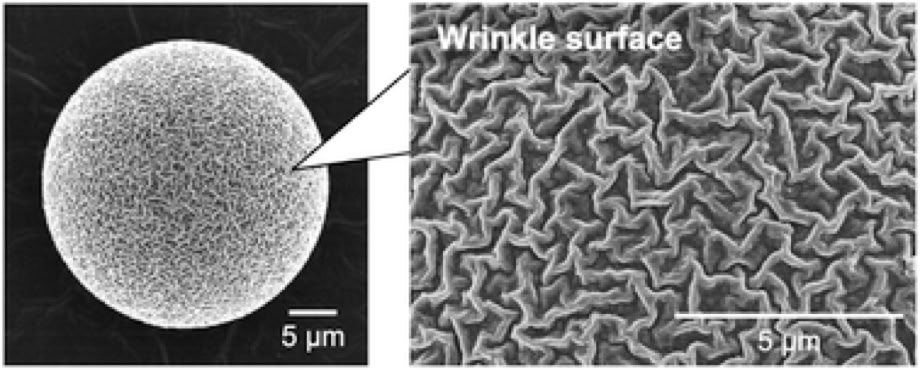
Induction of strong and tunable circularly polarized luminescence of non-chiral, non-metal, low-molecular-weight fluorophores using chiral nano-template.
T. Goto, Y. Okazaki, M. Ueki, Y. Kuwahara, M. Takafuji, R. Oda, H. Ihara.
Angewandte Chemie International Edition, Vol. 56, pp.2989-2993, 2017.
A new strategy is described for generating strong circularly polarized luminescence with highly tunable emission bands through chiral induction in nonchiral, totally organic, low‐molecular‐weight fluorescent dyes by chiral nanotemplate systems. Our approach allows the first systematic investigation to clarify the correlation between the circular dichroism and circularly polarized luminescence intensities. As a result, a dilute solution system with the highest circularly polarized luminescence intensity achieved to date and a dissymmetry factor of over 0.1 was identified.

A hetero-network hydrogel with self-assembled nanofibers as multiple-crosslinkers and its liquid-crystal-driven healing properties
M. Takafuji*, F. N. Robel, H. Ihara*.
Colloid and Interface Science Communications, Vol.19, pp.9–13, 2017.
Hetero-network hydrogels composed of hydrophilic polymers with terminal alkyl chains and nanofibrous self-assemblies were successfully fabricated. The gel formation was not observed in both cases of the self-assemblies in aqueous solution and hydrophilic polymer in aqueous solution. Furthermore the gel-to-liquid crystalline phase transition temperatures of nanofibrous self-assemblies were lowered by addition of hydrophilic polymers with terminal alkyl chains. From these observations, it was considered that the alkyl chains at polymer termini intercalated into the bilayer membrane-based nanofibrous self-assemblies to form cross-linking points. As far as we know, the hybrid hydrogel introduced in this communication is the first example of a hetero-network structure composed of supramolecular assemblies. When the hetero-network hydrogel was crushed by mechanical shearing, these hydrogels recovered by heating at temperatures above their gel-to-liquid crystalline transition temperatures.
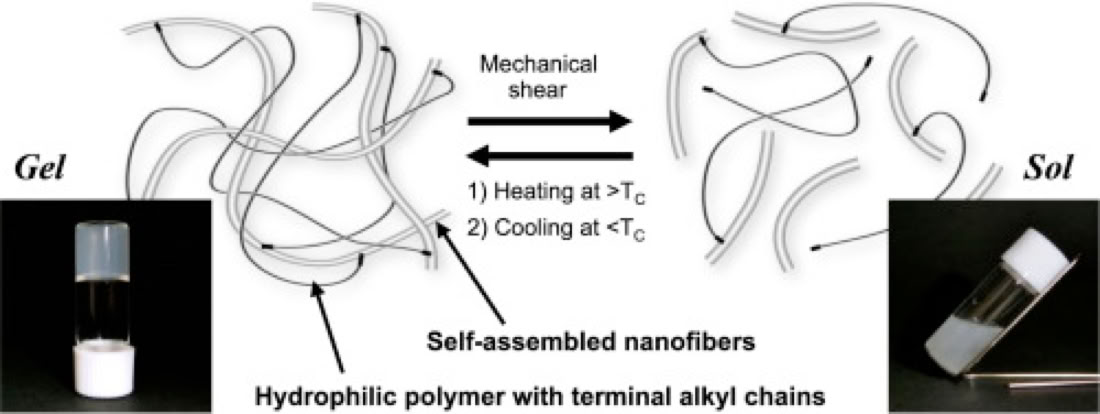
Chemically tunable cationic polymer-bonded magnetic nanoparticles for gene magnetofection.
M. Takafuji*, K. Kitaura, T. Nishiyama, V. Gopal, T. Imamura, H. Ihara*.
Journal of Materials Chemistry B, Vol.2, pp.644-650, 2014.
DOI: 10.1039/C3TB21290D
This study evaluates the efficiency of novel non-viral vectors consisting of super paramagnetic iron oxide nanoparticles functionalized with the chemically tunable cationic polymer for in vitro gene magnetofection. The cationic polymer, poly(vinyl pyridinium alkyl halide), with a reactive alkoxysilyl group at one terminal of the polymer (VPCmn, m = length of the side chain and n = polymerization degree), was grafted onto the surface of iron oxide nanoparticles through a silane coupling reaction. The VPCmn grafted-magnetic nanoparticles (Mag-VPCmn) were quaternized with various alkyl halides such as methyl iodide (m = 1), ethyl bromide (m = 2), butyl bromide (m = 4), hexyl bromide (m = 6) and octyl bromide (m = 8). Mag-VPCmn quaternized with a shorter alkyl chain (m = 1, 2, 4 and 6) were water dispersible, but that quaternized with a longer alkyl chain (m = 8) was precipitated in water. The surface of water dispersible Mag-VPCmns was positively charged in pH ranging from 2 to 11, and is stable for more than one month in this pH range. The complexes of Mag-VPCmns and nucleoside molecules with various N/P ratios were evaluated using gel electrophoresis, surface charge (ζ-potential) measurement, and particle size measurement. In vitro transfection experiments were assayed in human embryonic kidney 293 cells (HEK293 cells) using pmaxGFP plasmid as a reporter gene. Gene expression was found to be strongly influenced by the length of the side alkyl chains. Higher transfection efficiencies were observed with longer alkyl chains (C6 > C4 > C2 ≥ C1), indicating that hydrophobic side chains were effective in increasing the transfection efficiency.
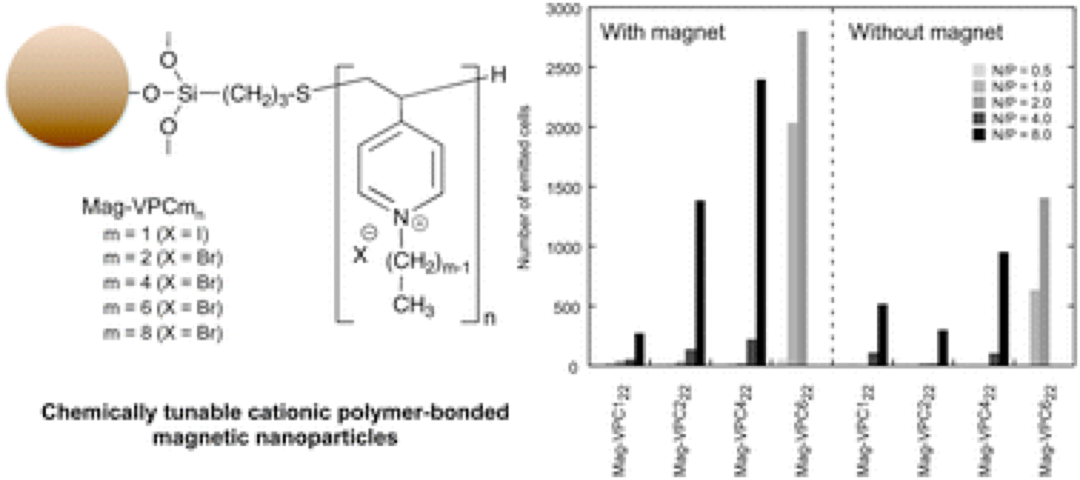
Strategy for preparation of hybrid polymer hydrogels using silica nanoparticles as multifunctional crosslinking points.
M. Takafuji, S. Yamada, H. Ihara.
Chemical Communications, 47, 1024-1026 , 2011.
DOI: 10.1039/C0CC02891F
Novel hybrid polymer hydrogels were prepared in a facile manner by simple mixing of a water-soluble copolymer having trimethoxysilyl side chains with silica nanoparticles used as multiple crosslinkers.
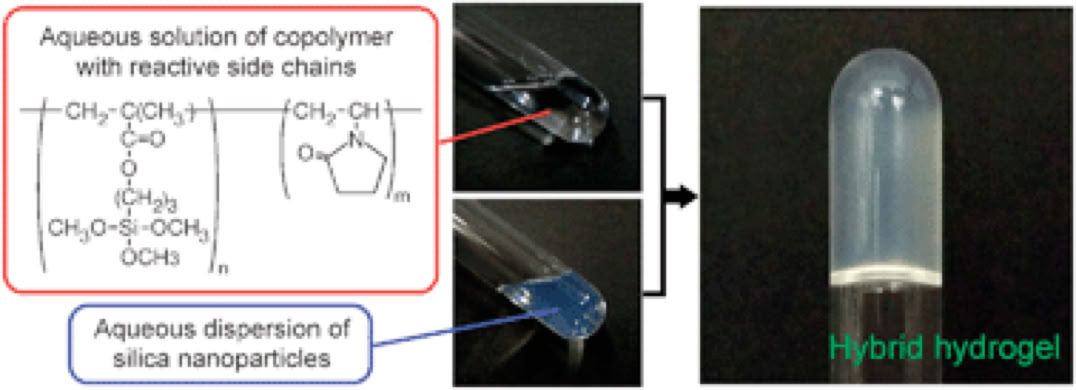
Polycondensation and stabilization of chirally-ordered molecular organogels derived from alkoxysilyl group-containing L-glutamide lipid.
M. Takafuji, N. Azuma, K. Miyamoto, S. Maeda, H. Ihara.
Langmuir, Vol. 25, pp. 8428-8433, 2009.
DOI: 10.1021/la804321u
A lipophilic l-glutamide-derived lipid with a triethoxysilyl headgroup (Si-lipid) was newly synthesized as a self-assembling organogelator to stabilize the chirally ordered state of the aggregates. The Si-lipid formed nanofibrous network structures in various organic solvents such as benzene, cyclohexane, and dimethylformamide and entrapped them to form gels. The gels were transformed to sols by heat, and this gel-to-sol transition was thermally reversible. Polycondensation of the triethoxysilyl groups was carried out by acid-catalyzed hydrolysis and condensation in a benzene gel and confirmed by 29Si CP/MAS NMR and FT-IR measurements. After polycondensation, a gel state was maintained, and the thermal and mechanical stabilities of the aggregates increased markedly. Interestingly, polycondensation in chloroform and acetonitrile induced gelation, whereas no gelation was observed before polycondensation. Xerogel, which was prepared by freeze drying organogels, had fibrous network structures similar to those of the original gels. A strong CD signal was observed around the amide bonds in a cyclohexane gel at 20 °C, indicating that the gel contained chirally oriented structures based on intermolecular hydrogen bonds. An enhanced CD signal was observed even after polycondensation of the ethoxysilyl group of Si-lipid (poly(Si-lipid)) and was maintained at 70 °C, which is above the temperature of the gel-to-sol phase transition of the original gel. These results indicate that the formation of siloxane network structure among the fibrous aggregates stabilizes the chiral orientation of lipid aggregates.

© April, 2019. Supramolecular Chemistry Group at KU